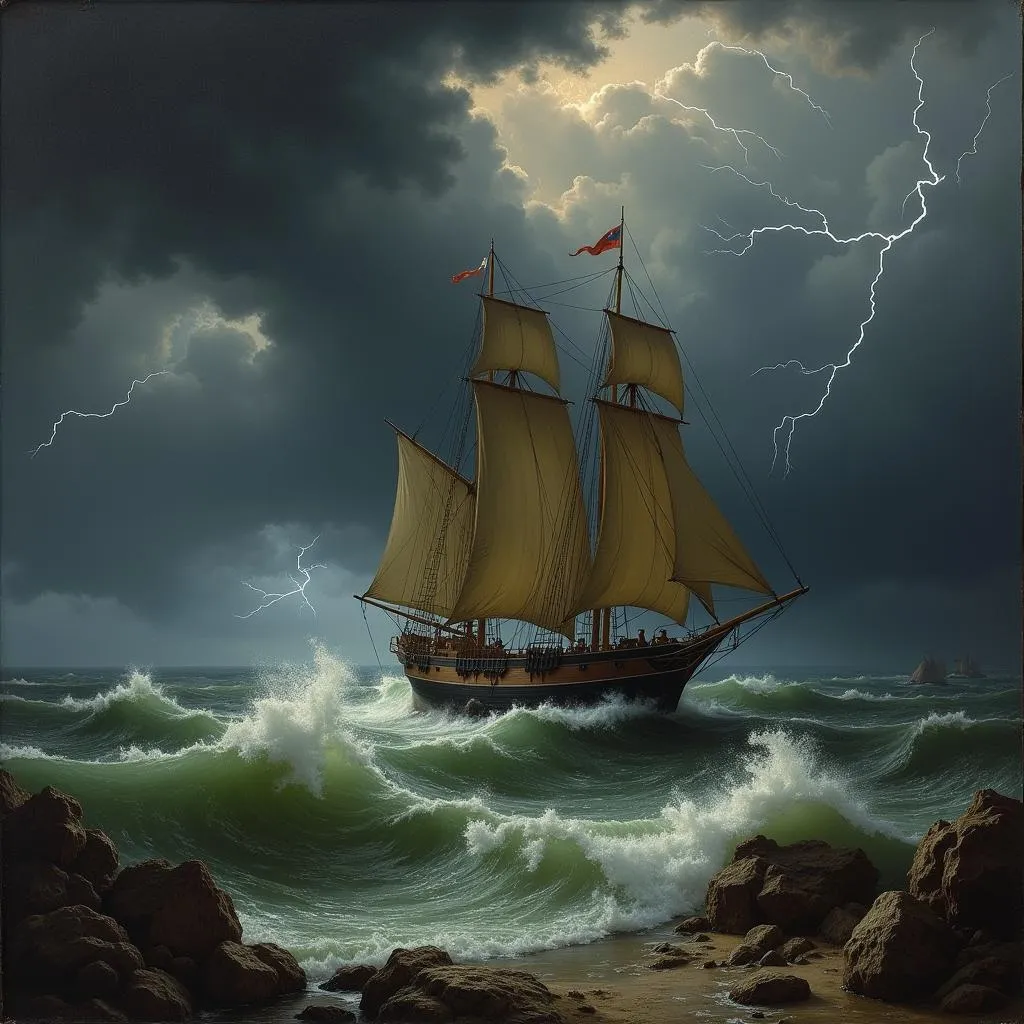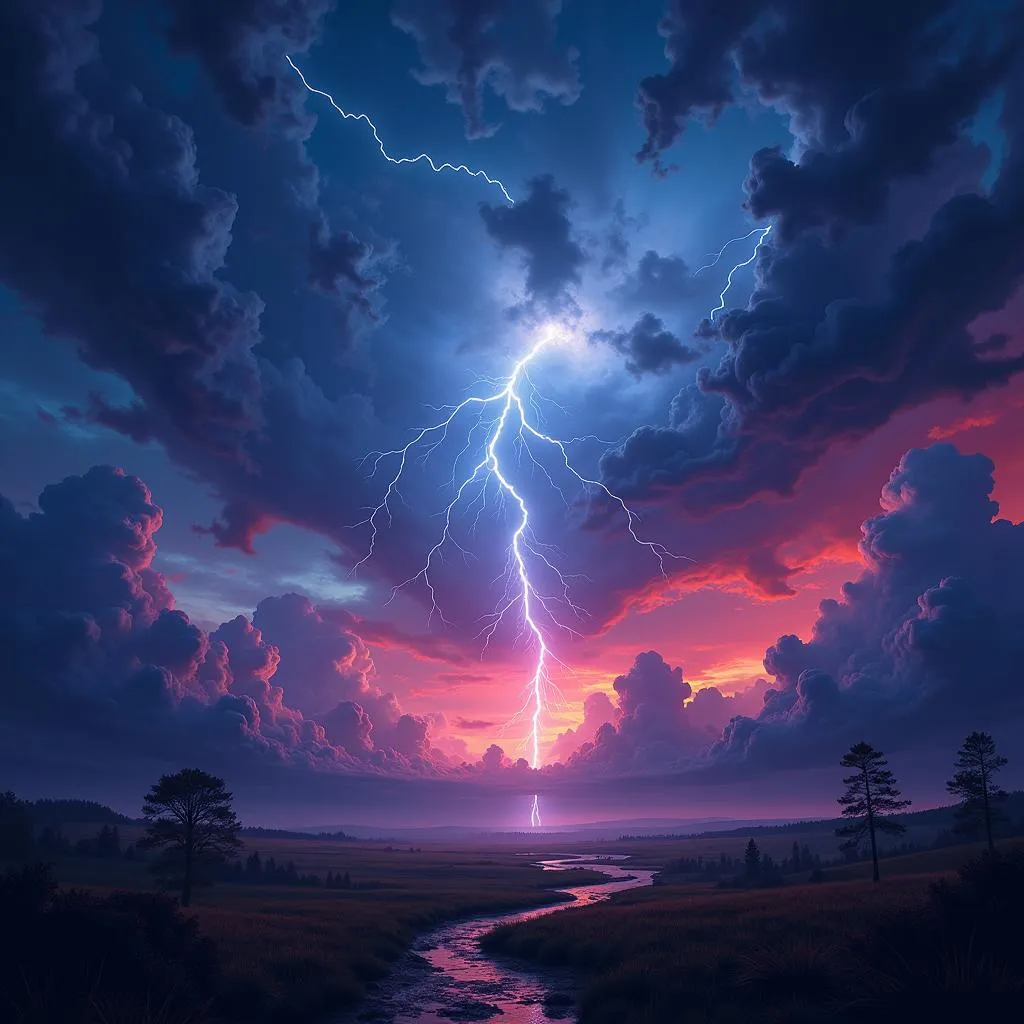Unleashing Emotion: Exploring the Depths of Storm Art
Storm Art, a captivating genre that merges the raw power of nature with the boundless realm of artistic expression, has enthralled audiences for centuries. From tumultuous seascapes to electrifying skyscapes, artists have long been drawn to the tempestuous beauty of storms, capturing their awe-inspiring grandeur and unleashing a torrent of emotions within their works.
The Allure of the Tempest: Why Storms Captivate Artists
 Tranh sơn dầu cơn bão trên biển thế kỷ 19
Tranh sơn dầu cơn bão trên biển thế kỷ 19
There’s an undeniable allure to the untamed fury of a storm. It’s a force of nature that commands respect, evokes a sense of awe, and ignites our primal instincts. Artists, with their keen eye for beauty in unexpected places, are naturally drawn to this spectacle of nature’s raw power.
Storms offer a powerful visual vocabulary:
- Contrasting light and shadow: The interplay of light and shadow during a storm creates dramatic scenes filled with tension and dynamism.
- Movement and energy: Artists can almost make you feel the wind whipping and the waves crashing through their brushstrokes and composition.
- Symbolism and emotion: Beyond the visual spectacle, storms have long been imbued with symbolic meaning, representing chaos, change, and the awesome power of nature.
Through the Ages: A Historical Glimpse into Storm Art
 Tranh khắc gỗ thần Zeus điều khiển cơn bão
Tranh khắc gỗ thần Zeus điều khiển cơn bão
From ancient times, storm art has held a prominent place in artistic traditions worldwide:
- Ancient mythology: Deities like Zeus and Poseidon were often depicted commanding the elements, showcasing the reverence and fear these cultures held for the power of storms.
- Storm god art: Across cultures, deities associated with storms inspired artists to depict their awe-inspiring presence amidst turbulent natural forces.
- Romanticism: This artistic and literary movement embraced the sublime and awe-inspiring aspects of nature, leading to a surge in dramatic storm paintings. Think of the turbulent seascapes of J.M.W. Turner or the dramatic skies of Caspar David Friedrich.
Capturing the Essence: Techniques for Depicting Storms
Artists employ a variety of techniques to effectively convey the intensity and drama of storms:
- Brushwork: Expressive, energetic brushstrokes can mimic the swirling winds and crashing waves, creating a sense of movement and chaos.
- Color Palette: Artists often use a limited color palette of dark, moody hues contrasted with flashes of bright light to create a sense of drama and foreboding.
- Composition: Diagonal lines and asymmetrical compositions can enhance the feeling of instability and movement, further immersing the viewer in the scene.
Beyond the Canvas: Storm Art in the Digital Age
 Nghệ thuật kỹ thuật số cơn bão siêu thực
Nghệ thuật kỹ thuật số cơn bão siêu thực
Today, digital tools offer artists exciting new avenues for depicting storms. Digital art and photography allow for greater manipulation of light, color, and texture, resulting in hyperrealistic or surreally abstract interpretations of storms.
- Photo manipulation: Photographers can capture the raw power of a storm and then enhance specific details or create composites for even greater visual impact.
- Digital painting: Digital artists utilize software to mimic traditional techniques while exploring innovative ways to blend textures, colors, and effects for breathtaking results.
- Animation and VFX: Storms are frequently depicted in animation and visual effects, bringing to life everything from fantastical storms in movies to realistic weather simulations in video games.
Storm Art: A Reflection of Ourselves?
Beyond their visual splendor, storm artworks often serve as powerful metaphors, prompting viewers to contemplate larger themes:
- Human vulnerability: The sheer power of a storm reminds us of the forces beyond our control and our own fragility in the face of nature’s might.
- Emotional turmoil: The chaos and turbulence of a storm can mirror our own internal struggles, anxieties, and moments of upheaval.
- Hope and renewal: Just as storms eventually subside, they can symbolize periods of transformation and the promise of calmer times ahead.
FAQ: Delving Deeper into the World of Storm Art
1. What are some famous examples of storm art?
Some iconic examples include Hokusai’s “The Great Wave off Kanagawa,” Turner’s “The Slave Ship,” and Courbet’s “The Wave.”
2. How has technology influenced the way storms are depicted in art?
Technology has opened up new possibilities for capturing and manipulating images, allowing artists to create hyperrealistic or abstract depictions of storms.
3. Why do you think storm art continues to resonate with audiences today?
Storms remain a powerful symbol of nature’s beauty and ferocity, evoking a range of emotions and prompting reflection on our place in the world.
Seeking Inspiration? Dive into These Related Topics:
- Jesus calms the storm art: Explore religious art that depicts the power of faith amidst tumultuous natural events.
- Mine art: Discover the unexpected beauty found in art inspired by industrial landscapes, often contrasting with the raw power of nature.
- Apex future martial arts chapter 70: Explore the world of martial arts and discover how themes of discipline and resilience can be seen as parallels to weathering life’s storms.
Need Help Navigating the Creative Storm?
Contact us at Phone: 02462573573, Email: [email protected], or visit us at Savico Megamall, 7-9 Đ. Nguyễn Văn Linh, Gia Thụy, Long Biên, Hà Nội 10000, Việt Nam. Our dedicated support team is available 24/7 to assist you on your artistic journey.



